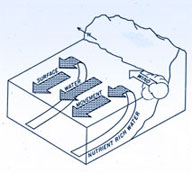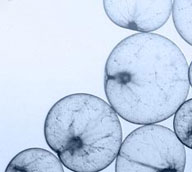Effects of Nutrient Enrichment

There are many sources of nutrients and many routes by which these nutrients can find their way into coastal waters, some natural and some man-made (anthropogenic). For example, natural sources include outflow from productive river estuaries that export nutrients incorporated into lush growth of macrophytes and phytoplankton into adjacent coastal waters as living organisms, detritus (dead material derived from biota), or dissolved material recycled by the activities of bacteria and protists.
Hydrographical factors such as eddies and internal waves can transport deeper water from below the euphotic (well-lighted surface waters) zone onto the shelf to mix with water closer inshore, fertilising it with nutrients that were previously in regions too dark for plants to exploit in photosynthesis.

Where currents, e.g. the East Australian Current, run southwards strongly parallel to the coast, in regions where they separate from the shelf, deep water is transported to the right of the current by friction with the seabed i.e. towards the coast. Wind patterns in some coastal regions of the globe blow surface waters away from coasts causing deep nutrient-rich water to be sucked up to replace it.
This latter process is called upwelling. It is so effective in increasing productivity that over 50% of the world's fish catch is taken from upwelling areas even though they represent less than 1% of the ocean surface.
Anthropogenic sources of nutrients include ocean sewage outfalls, pulp mill effluents and coastal fish farms. Whatever the source of additional nutrients, the initial effect is usually to stimulate primary production i.e. a great increase in biomass of phytoplankton. This is particularly true if the added nutrients are rich in nitrogen, which is often a limiting nutrient in seawater.
Zooplankton respond to this massive increase in plant material by a corresponding increase in small, rapidly reproducing taxa, e.g. protists, cladocerans and copepods. This increase might occur in just 1–2 weeks. Thus the size structure of the zooplankton community typically changes in favour of the smaller bodied types. If the nutrient enrichment is episodic, these small-bodied colonisers gradually give way to larger bodied taxa and the community will revert to its earlier composition. If, however, the enrichment is persistent, the community structure may switch, with different organisms becoming dominant.
There are documented cases of severe nutrient enrichment (hyper-eutrophication) in which dense 'red tides' of dinoflagellates or plagues of jellyfish have become commonplace where they were rare or absent before nutrient enrichment occurred.

